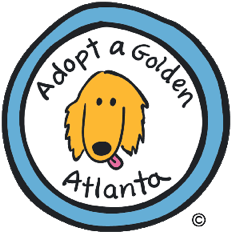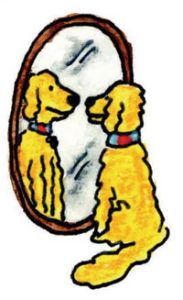If you’ve found your dog standing in front of the mirror asking, “Does this collar make me look fat?” there is a very good chance the answer is YES. The fault lies neither with the collar nor the mirror since recent studies show that 40% of dogs in the United States are obese—defined as 20% over their ideal weight.—and many more dogs fall into the overweight category. If an average Golden Retriever who should weigh 70 lbs weighs in at 84 pounds, he is obese. As a matter of fact, fat dogs are so common that when a picture of a dog of normal weight and body composition is shown to a group of people most say the dog looks starved. Also, a word of apology to any dog reading this that falls into either the obese or overweight category: no offense is intended, but for simplicity’s sake, the term “fat“ will be used for the rest of this article.
Issue
Dogs that are fat are at risk for serious medical problems; they are more at risk when sedated for surgery and dental cleanings, more prone to injury (think torn knee ligaments and subsequent surgical repair) and have more stress on heart, lungs, liver, kidneys, and joints. Excess weight can worsen osteoarthritis, cause respiratory problems in hot weather and during exercise, lead to diabetes and generally lessen the QUALITY AND QUANTITY of life for your dog. Surely this is not new information for any dog owner; however, as the large population of fat dogs proves HUMANS ARE NOT TAKING IT SERIOUSLY and neglect to do what needs to be done to keep their dogs at a healthy weight. Therefore, here is another statistic that is impossible for anyone who loves their dog to ignore: the life span of fat dogs is reduced by 15% compared to dogs of normal weight. Golden Retrievers of a normal weight live an average of 10 -13 years; for a fat golden that changes to 8.5 – 11.5 years…
Physical Assessment
Ok, so first things first: how do you know if your dog is fat? Certainly, your vet is an excellent source of information and can readily give you specific information about your dog’s optimum weight. However, you can also easily ascertain and monitor your dog’s weight by performing these checks on a regular (bi-monthly at a minimum) basis. While the dog is standing, place your hands on either side of the dog’s chest. With gentle pressure, you should be able to readily feel each and every rib. If you can’t, your dog is fat. Next place you hands on the either side of the dog’s shoulders and move them slowly down the body towards the tail, if you can’t feel a definite indentation at the “waist,” your dog is fat!
Food
Dogs are fat because they are consuming more calories than they are burning, so to lose weight they need to eat less and exercise more! The quality and amount of dog food you feed your dog is critical, (for information about selecting a quality dog food, please refer to the article named “What’s for Dinner,” which can be found on our website here ). Concerning the amount, the first thing to know is that the portion recommended on the dog food bag is generally far too much…at least for Golden Retrievers who tend to easily gain weight. Although the amount of food is determined by several factors including the amount of exercise the dog is getting , a general rule of thumb is 1 cup of food per 35 lbs. desired weight PER DAY( i.e., if your dog should weigh 70 lbs, you would be feeding 2 cups total per day). Be sure to check that what you think is a one cup measure really is, Many of the scoops labeled 1 cup are very inaccurate, In a test of 4 scoops labeled 1 cup, one was 1 1/2 cups and the others were between 1 1/4 and 1 1/2. The best thing is to dedicate an actual kitchen measuring cup for dog food. And be sure to include treats in the total calorie count. Although this is no surprise to the loving human of any Golden Retriever, but to state the obvious, they have very big appetites and most of them behave as if they are starving to death minutes after eating their meal. YOU MUST LEARN TO IGNORE THEM AND THEIR SAD, IMPLORING LOOKS. This may be one case where it really is harder on you than it is on them, but, as a responsible pet owner, it is your job to keep them at a healthy weight and that means you have to just say no! No extra dog food, no extra treats and above all NO PEOPLE FOOD!!!
Exercise
What about exercise? Although most of us are not traipsing through field and stream on a daily basis, we need to remember that Goldens were bred to be outdoors for hours in extreme weather and terrain retrieving ducks, and, therefore, we need to honor their heritage and provide them with sufficient exercise. Meeting that need, however, can be a challenge. A romp in the backyard several times a day is not sufficient. The consensus among Golden experts is that—at minimum— a Golden must have hard, consistent exercise daily. Rapid walking (not a leisurely stroll), running or swimming is fine. If you are wondering how much enough is, one Golden expert states “anything less than 3 miles isn’t enough, five is good, anything more than that is gravy.” Another expert say that dogs under five need two vigorous walks for 30 minutes daily and at least another 30 minutes of supervised play with a tennis ball, Frisbee, etc. Older dogs need 60 minutes of walking daily broken into either two or three walks depending on their ability and stamina and 30 minutes of play 3-5 times a week. Of course older dogs and dogs with health issues may need less exercise but the point is every Golden that is physically able needs to be walked at least twice a day and generally the farther and faster the better. Sufficient exercise is so critical to a Golden’s mental and physical well-being that one Golden expert states, “If you cannot fit vigorous, twice-daily exercise into your schedule–DON’T GET A GOLDEN“ or be prepared to hire a dog walker.
Caution
If your dog is fat, you must first rule out any underlying health issues. Goldens are very susceptible to thyroid disease which will cause weight gain; this is a serious condition that needs to be corrected with medication. Also a crash diet and exercise plan is dangerous! The desired weight lose goal is gradual and no more than 2% of body weight per week, and if you have allowed your dog to be a couch potato you need to gradually introduce exercise to build stamina and exercise tolerance. Remember heat stroke is a real, serious and potentially deadly condition so on hot and humid day restrict your dog’s physical activity to the early morning and evenings. In Atlanta, depending on the time of year, this could mean that the temperature and humidity will rule out any outdoor exercise between 9:00 AM and 9:00 PM.




